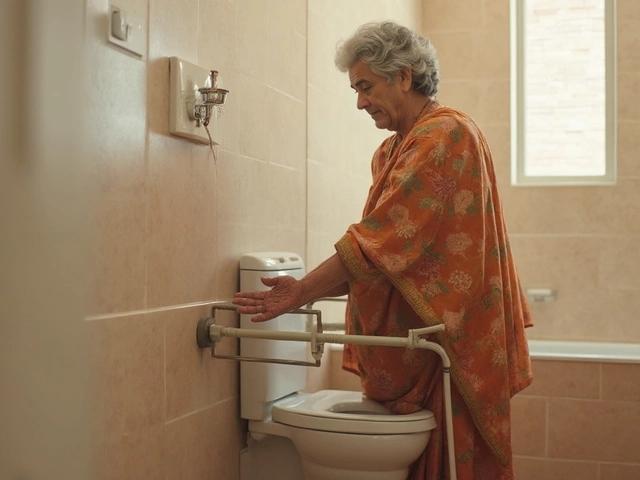
If you’ve had a knee replacement, that stiff, stubborn feeling when you try to bend or straighten your leg can be pretty frustrating. It’s common, but it doesn’t have to stick around. Small changes in the way you move and a few smart exercises can make a world of difference.
The trick is, you want your new joint to move, but not in a way that risks injury or messes with healing. That tight, pulling feeling? It’s usually just swelling, some scar tissue, or your muscles being lazy after a long rest. Sometimes you just need to nudge your knee in the right direction—gentle stretches, regular walking, and even using an ice pack can help calm things down. No need to become an athlete; it’s about smoother, easier movement for daily life.
- Why Your Knee Gets Stiff After Surgery
- Easy Moves for a Looser Knee
- Red Flags—When to Call the Doctor
- Choosing the Right Help
Why Your Knee Gets Stiff After Surgery
Most people feel their knee tighten up after surgery, and it’s actually pretty normal. Your body just went through a big change, so your knee is reacting to the procedure, healing process, and how much (or little) you move after.
The most common reasons for a stiff knee after knee replacement are swelling, scar tissue, muscle weakness, and pain that makes you avoid movement. When you sit still or don’t bend your knee much, your body starts laying down extra scar tissue, which acts like glue and limits your range of motion. The longer you’re inactive, the more stubborn that stiff feeling gets.
Right after surgery, the body sends fluid to the area to help heal. This swelling can make it hard to bend or straighten the knee. Plus, the pain might make you hesitant to push through normal movements, which slows down progress even more. Your muscles, especially the quadriceps (the big ones in the front of the thigh), can get weaker with too much rest, which makes it tough to support the new joint.
| Cause of Stiffness | How It Shows Up | Tips to Help |
|---|---|---|
| Swelling | Puffy, tight skin; hard to bend | Use an ice pack; keep the leg elevated |
| Scar tissue | Catches or blocks the knee movement | Gentle stretching, early motion |
| Pain avoidance | Afraid to move the joint fully | Pain meds as recommended; slow, regular activity |
| Muscle weakness | Wobbly, weak leg; knee won’t support you | Basic strengthening exercises |
Typically, if you don’t get at least 90 degrees of bend (about what you need for most chairs) within two to three weeks after surgery, it’s a sign that stiffness could become a real problem. That’s why most doctors and physical therapists push early movement and daily stretches, even if it feels tough at first. Small, steady changes can add up fast.
Easy Moves for a Looser Knee
Getting a stiff knee moving again comes down to being smart, consistent, and gentle. You don’t need fancy gear—in fact, the best moves barely take up any space at all. Studies from big orthopedic centers show that people who stick with daily knee mobility exercises see way better range of motion than those who don’t. So, habit really is your best friend here.
Here are some tried-and-true moves you can start today:
- Heel Slides: Lie on your back, bend your knee and slowly slide your heel toward your butt, then slide it back out straight. Don’t push through pain—just go until you feel a stretch. Aim for 10-15 reps, a few times a day.
- Seated Knee Bends: Sit on a chair with your foot flat. Slowly slide your foot back under the chair, bending your knee as far as comfortable. Hold it for 5 seconds, then return. Do this 10 times, once or twice a day.
- Straight Leg Raises: Lying on your back, tighten your thigh and lift your leg straight up without bending your knee. Hold for a few seconds, lower, and repeat 10 times per leg. Good for keeping your thigh muscles strong.
- Ankle Pumps: Flex your foot up and down from the ankle. This gets your blood moving and helps with swelling—a bonus for stiff knees.
Sticking to a routine is what really counts. Some folks keep moving by doing a few exercises right after they get out of bed and again before dinner. Short sessions add up.
Check out the kind of progress you might see if you keep at it. Numbers come from real-world physical therapy data:
| Week After Surgery | Average Knee Bend (Degrees) |
|---|---|
| 1 | 50° |
| 2 | 75° |
| 4 | 95° |
| 8 | 110° |
Not everyone moves at the same pace, but if you’re not seeing steady improvement or you hit a plateau, ask for advice. Sometimes what feels like a "stubborn" stiff knee just needs a tweak in your routine, or help from a professional, to get going again.

Red Flags—When to Call the Doctor
Your knee’s giving you a hard time, but sometimes, it’s more than just a little stiffness. It's key to know when you need backup. Certain problems after a knee replacement just aren’t worth waiting out at home.
Any of these signs? Put the phone in your hand, not your pocket:
- Sudden or severe pain—especially pain that’s worse than it was a day or two ago, or pain that just shows up out of nowhere.
- Fever of 101°F (38.3°C) or higher. Even a slight fever that sticks around could mean infection.
- Redness and warmth around the knee joint that’s spreading or not getting better.
- Oozing—if fluid, blood, or pus leaks out from your incision, it’s time for a doctor’s help.
- Leg swelling that won’t quit, especially if your foot or calf looks and feels bigger than your other leg.
- Can’t move your knee at all, or you’re losing the ability to bear weight.
Worried about how common these are? Take a peek at the stats for issues after knee surgery:
| Problem | Estimated Frequency |
|---|---|
| Infection | 1-2% |
| Serious bleeding | Less than 1% |
| Blood clots | 0.5-1.5% |
| Joint stiffness (needs more surgery) | 1-5% |
If you’re worried but not sure, call anyway. It’s not about being tough. Your new knee should be helping you walk, not sending up warning signals.
Choosing the Right Help
Sometimes, working on a stiff knee at home isn’t enough. If you notice swelling that doesn’t quit, pain that’s getting worse, or your knee just won’t bend past a certain angle—don’t tough it out alone. Getting help from the pros can speed up your recovery and keep setbacks to a minimum.
Most people start with a physical therapist after knee replacement. These folks know the difference between normal healing pain and "something’s not right" pain. A therapist will teach you targeted moves that push your joint’s range of motion, but in a safe way—even if it means stretching just an extra degree or two each day. In fact, data shows people who attend regular PT sessions get their knee motion back faster. Here’s a quick look:
| Rehab Option | Average Knee Bend After 6 Weeks |
|---|---|
| Ongoing Physical Therapy | 120 degrees |
| Minimal/Home-Only Exercises | 105 degrees |
If therapy isn’t making a dent, your surgeon might recommend more hands-on help. Manipulation under anesthesia (or MUA) is a real thing: they put you to sleep and gently force the knee to move, which can break up stubborn scar tissue. MUA isn’t fun, but it can save a knee from being locked long-term.
When picking a physical therapy clinic or provider, ask about their experience with knee replacement patients. Some therapists have special tricks up their sleeve—like water exercises or using special machines that help improve flexibility and strength. If you ever feel like you’re not making progress, don’t hesitate to talk to your doctor. Early action can mean a better and easier bend in your new knee.
- Look for physical therapists who specialize in knees.
- Keep all your scheduled sessions, even when it feels tough.
- If you can’t bend past 90 degrees after 4-6 weeks, bring it up with your doctor right away.
- Switch clinics if you’re not seeing improvement—finding the right match matters.





Rohan Talvani
I am a manufacturing expert with over 15 years of experience in streamlining production processes and enhancing operational efficiency. My work often takes me into the technical nitty-gritty of production, but I have a keen interest in writing about medicine in India—an intersection of tradition and modern practices that captivates me. I strive to incorporate innovative approaches in everything I do, whether in my professional role or as an author. My passion for writing about health topics stems from a strong belief in knowledge sharing and its potential to bring about positive changes.
view all postsWrite a comment